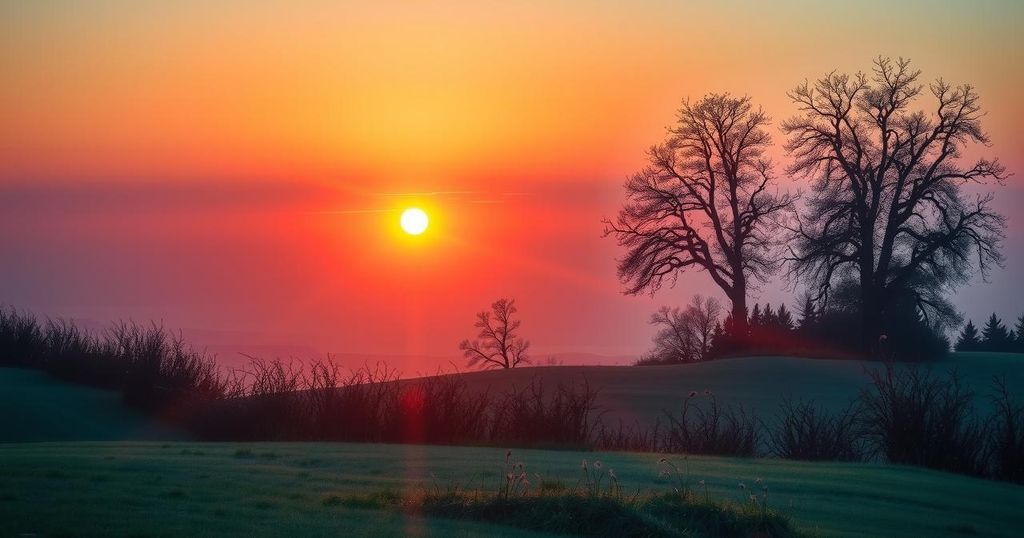Understanding the Climate Crisis: California’s Inherent Aridity and the Impact of Global Warming
The article discusses the ongoing climate challenges faced by California, particularly due to extreme weather and persistent dryness. It highlights that climate change exacerbates these issues but that the arid nature of the region has historical roots. The article also addresses the political implications of climate action and the long-standing struggle of communities trying to adapt to their changing environment.
The extreme weather events that have besieged various regions of the United States in recent years highlight a pressing dilemma; while climate change plays a significant role, there are deeper systemic issues at work, particularly in California. The wildfires ravaging Los Angeles are emblematic not only of rising temperatures but also of the inherent dryness of the region, a characteristic that has been overlooked for far too long. Hollywood may attempt to recreate green landscapes through elaborate sets, yet the reality remains that California’s climate has always been arid and is further exacerbated by the ongoing increase in global temperatures.
In examining the climatic conditions of California, it is alarming to note that Los Angeles is drier than Beirut, and even Sacramento parallels regions bordering the Sahara Desert. The data underpinning this assertion were meticulously gathered by Marc Reisner nearly four decades ago in his influential work, “Cadillac Desert: The American West and Its Disappearing Water.” Reisner delineated the extreme measures taken, such as extensive dam and irrigation projects, to mask the aridity of the West.
The late 19th century saw explorer John Wesley Powell establish the “Hundredth Meridian,” a geographical dividing line that demarcates the humid East from the arid West. As settlers migrated westward, they endeavored to replicate the lushness of the East, often ignoring the intrinsic beauty of the desert landscape. This misconception has led to misguided policies and practices, such as Nevada’s previous ban on water metering, which only worsened the situation.
The history of water management in California is intertwined with the ongoing battle against natural dryness. San Francisco, which had no trees at its founding, now boasts a transformed landscape due to artificially supplied water. Nevertheless, climate change is overriding human efforts to maintain an illusion of green amidst an increasingly dry reality. As climate scientists project greater heat increases than previously predicted, urban areas are notably vulnerable.
The political context surrounding climate change also poses significant challenges. President-elect Donald Trump’s stance against climate initiatives threatens to undermine essential strategies aimed at mitigating this existential crisis. Past fires, including the devastating 2018 Camp Fire, underscore California’s vulnerability, particularly in denser communities where firefighting resources are inadequate to combat massive wildfires.
Despite ongoing adversity, some residents express resolute intentions to rebuild their homes, yet they face an inevitable shift in environmental conditions that demands adaptation to an increasingly arid landscape. As the American West endures persistent drought, it is crucial to acknowledge that the region’s inherent dryness is not merely a consequence of climate change, but rather an enduring characteristic ingrained in its geography. Moving forward, leadership committed to tackling climate change will become imperative, yet the arid nature of the West will remain a steadfast reality.
The article addresses the extreme climate challenges faced by regions in the United States, particularly California, in light of climate change. It emphasizes that while climate change indeed heightens the frequency and intensity of natural disasters such as wildfires and floods, the fundamental dryness of the American West has historical roots and geographical realities that cannot be altered simply by human intervention. The discussion is informed by historical perspectives and current weather data to underline the severity of the situation.
In summary, the rising frequency of catastrophic wildfires in regions such as Los Angeles reveals a complex interplay between climate change and the region’s historical aridity. As the consequences of climate change become more dire, it is paramount for communities to acknowledge the inherent characteristics of their environment and adapt accordingly. The path forward will require recognition of both the geographical reality of the West and the urgent necessity for effective climate action policies to safeguard the future of these vulnerable communities.
Original Source: www.creators.com




Post Comment